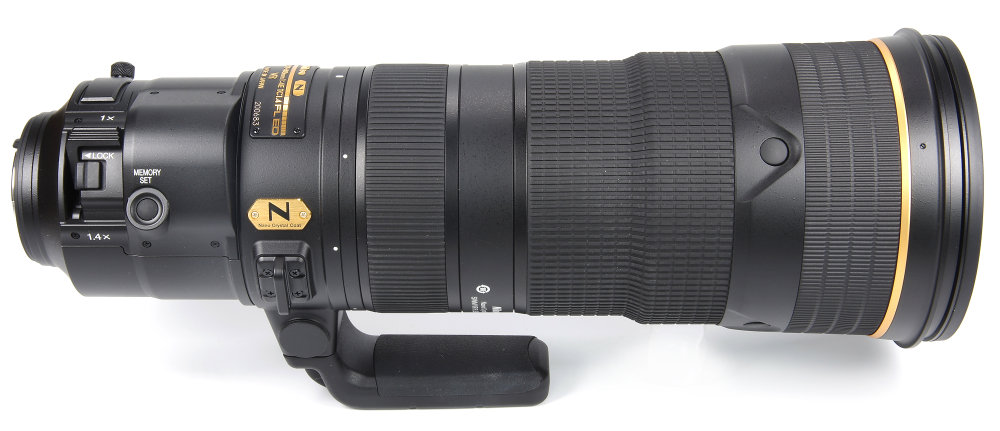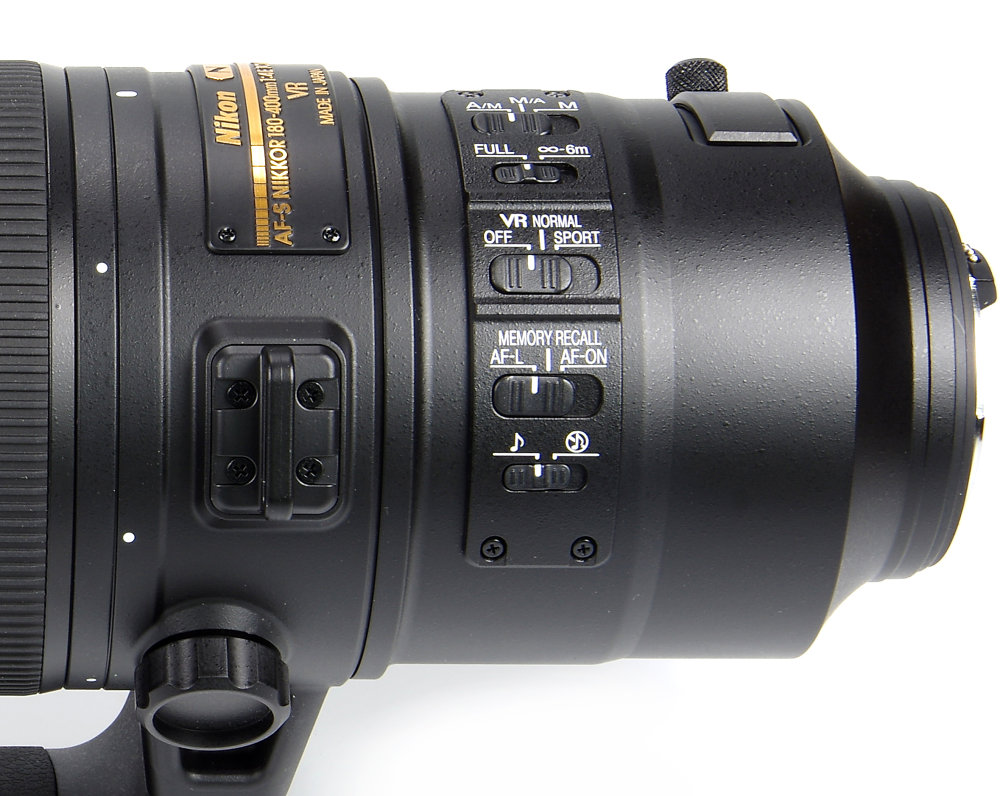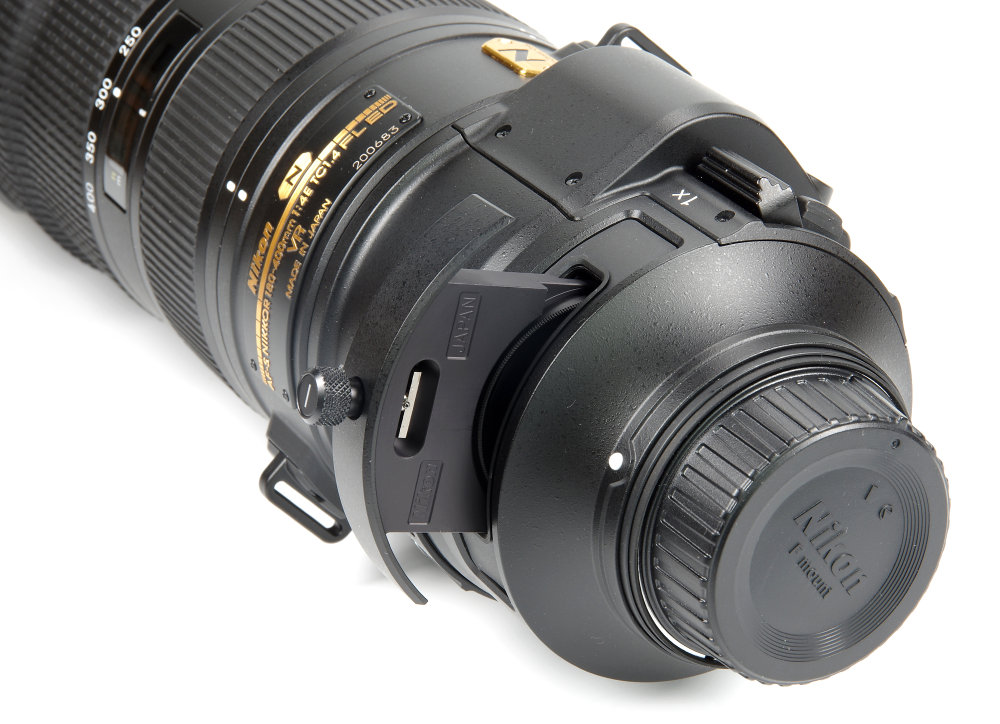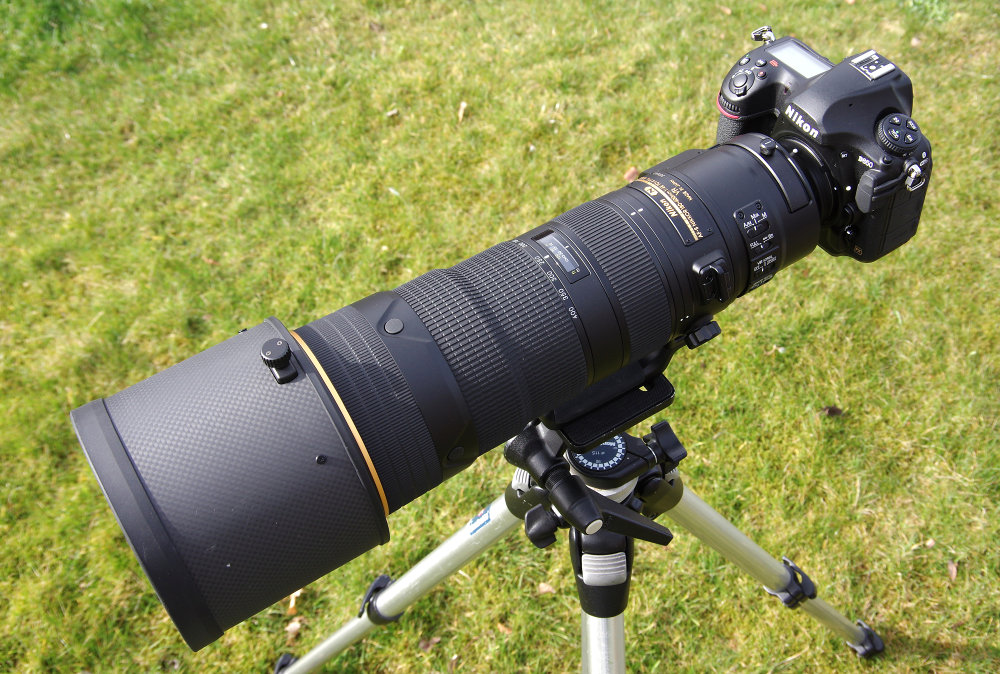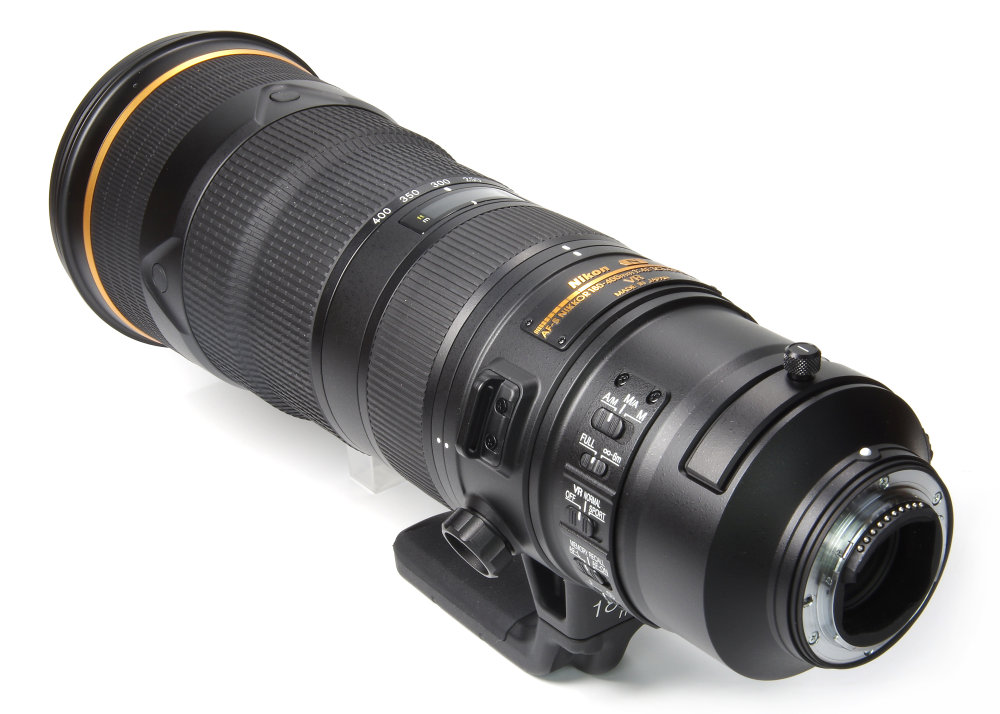Nikon AF-S Nikkor 180-400mm f/4E TC1.4 FL ED Review
Nikon AF-S Nikkor 180-400mm f/4E TC1.4 FL ED Handling and Features
It will be little surprise that the quality of construction is very, very high. Weighing in at a substantial 3500g the lens is no lightweight, but it is reasonably compact for its specification and balances well on the Nikon D850 body. It is usable handheld, but the weight means it is probably more comfortable on a tripod or monopod.
We commence our tour of the lens at the front element, fluorine coated, which is intended to repel grease and water. There is no front filter thread and the large round lens hood simply slides into position, held in place by a knurled knob that tightens onto the edge of the barrel. This method will be familiar to users of long Nikon lenses. It is simple and it works.
There are four equally spaced buttons around the front of the lens barrel. These are Focus Function buttons and will activate whatever parameter has been set on a switch near the lens mount. These options are AF-L (Focus Lock), Memory Recall (Saves a frequently used focus position) and AF-ON (Focuses using AF).
Moving towards the camera body we find a wide and comfortable zoom ring. This is clearly marked in focal lengths for the main lens alone, rather than the lens plus converter. The action is smooth and even. As we zoom, focus holds well, indicating a parfocal design. However, it is hard to break the usual habit of zooming and then focusing. Behind the zoom ring is the distance scale, located under a clear window. Indications are in feet and metres. Focusing is down to 2m or 6.6 feet, giving a maximum magnification of 0.25x, or 0.36x with the converter switched in.
Behind this is a manual focus ring, again well damped and very smooth in operation. Manual focusing is possible during AF operation, always a useful feature for a final tweak of the focusing position, or perhaps when the subject is unsuitable for AF.
Continuing, we have a ring that contains the tripod foot. The ring can be easily turned to provide for vertical and well as horizontal shots. There are no click stops in this, so the range of adjustment is continuous. The ring is locked by a knurled knob. Also, at this point, we find two tethering points where the lens can be attached to a tether or tethers for security.
Further back again, a series of switches control various options. The first sets AF/MF options, A/M (AF with manual override but AF priority), M/A (AF with manual override but Manual priority) and M (Manual focus with electronic rangefinder). The difference between A/M and M/A is that with the former it takes a longer turn of the focusing ring for manual focus to be engaged during AF operation. With M/A the effect is immediate.
The second switch is the focus range limiter. This can be set to Full or limited to between infinity and 6m. The limiter will speed up AF where longer focus distances only are being used.
The third switch controls the VR (Vibration Reduction) system and has options Off, Normal and Sport. The Sport setting may be more suitable when panning. Four stops advantage is claimed.
The fourth switch controls the settings of the Memory Recall system. AF-L locks focus, Memory Recall is a saved distance setting and AF-ON activates AF.
There is a fifth switch that switches a beep on and off. This applies to the Memory Recall functions.
On the opposite side of the barrel is the Memory Set button.
At the closest point to the lens mount, we have a filter slot that enables 40.5mm filters to be employed. A clear filter is supplied that must be used if no filters are needed.
Finally, on the right side, there is a substantial switch that can be thrown to either enable or disable use of the built-in teleconverter, engaging either option with a satisfyingly heavy clunk. There is also a firm locking catch so the setting cannot be accidentally changed.
Optical construction is a massive 27 elements in 19 groups, having 8 ED (Extra Low Dispersion) and 1 Fluorite element, plus Nano Crystal coatings. The 1.4x teleconverter adds in another 8 elements in 5 groups. The E diaphragm (electronically operated) has 9 rounded blades to enhance the bokeh, although long lenses, in any event, tend to throw the background out of focus very effectively. Only camera bodies that support use of the E diaphragm can be used, all others will shoot with the lens always wide open. The E diaphragm is accurate and silent in operation.
With the teleconverter switched in cameras that enable f/8 AF support will be needed to ensure the AF system continues to operate. Compatibility can be checked on the Nikon website, but the following are listed in the instruction leaflet as being incompatible: D2-series, D1-series, D200, D100, D90, D80, D70-series, D60, D50, D40-series, D3000 and all film SLR bodies.
Of course, the built-in TC does mean that there is an overlap of options and, for example, it is possible to set say 250mm both with or without the TC. In practice, for maximum quality, it might be marginally better to use the lens without, but this is largely academic and for wildlife and sports using the TC will bring in that extra reach, still with the ability to zoom out when needed. It all works out rather well in the field and, despite the weight, the lens handles nicely on the D850. For static work, a tripod makes life easier, but for sports and wildlife handheld use is straightforward enough.
Add your message
Please login here or if you've not registered, you can register here. Registering is safe, quick and free.
photodo Stats
428 MTF tests
74 in-depth photodo reviews
100+ users join each day
Help the lens community by reviewing or rating a lens today via our lens search
Latest Lens Reviews
- Chinon 28mm f/2.8 Vintage Lens Review
- Canon EF 70-200mm f/4L IS II USM Lens Review
- Samyang AF 85mm f/1.4 EF Review
- Sigma 70mm f/2.8 DG Macro Art Review
- Samyang AF 24mm f/2.8 FE Review
- Meike 50mm f/1.7 Review
- Tamron 70-210mm f/4 Di VC USD Review
- Lensbaby Burnside 35mm f/2.8 Review
- Asahi Super Takumar 50mm f/1.4 Review
- Asahi Super-Multi-Coated Takumar 135mm f/3.5 Review
